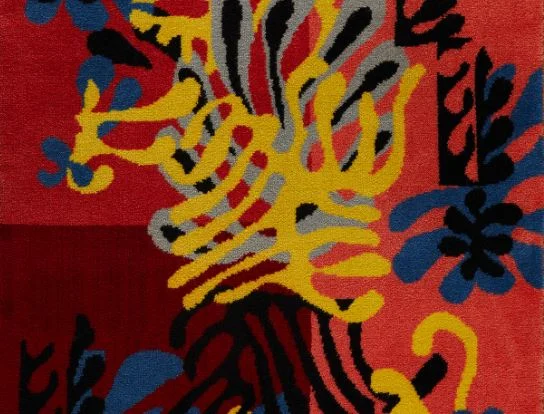This Bible first entered our client's family in 1889, and had been passed down to her through her mother's side of the family, who had emigrated from Ireland to Philadelphia. Though she and her mother hadn’t used the Bible in quite some time, it was a treasured family heirloom that our client was eager to see repaired. She entrusted Bill Paulson, owner of the Apple Frame Studio in Mundelein, Illinois, to see to that the Bible be restored to its former condition. Bill, who has frequently worked with The Center on behalf of his clients, knew this was a job for our conservators.
Timeless Techniques: Treating a Gilded Mirror
The Center's Gilding Department specializes in the preservation of frames and objects with gold, silver, and metal leaf applied to the surface. A wonderful example of the type of projects our Gilding Conservators frequently undertake recently came to us in the form of a mirror in need of conservation.
A Cabinet of Curiosities: Framing a Robert Rauschenberg
Robert Rauschenberg is frequently remembered for his series of work created in the 1950s and 1960s that combined aspects of both painting and sculpture. Rauschenberg himself called them "Combines", a term he invented to describe a work that is neither a sculpture nor a painting, but rather a hybrid of the two. The artist was always one to experiment and fuse, often creating something entirely new from two entirely different substances.
Henri Matisse's Textiles: Conserving a Mimosa Rug
Known mainly for his colorful paintings and abstracted paper cutouts, Henri Matisse is a name familiar to art enthusiasts and casual museum-goers alike. Perhaps not as well-known is Matisse’s deep and life-long connection to textiles and fabrics. When The Center recently encountered an example of one of the artist's textile designs, we knew there must be a story behind it.
An Arctic Journey: Conserving a Pair of North Pole Novels
As the summer season is in full swing and many of us are enjoying long weekends by the lake, one of The Center’s client is taking his travels in a different direction. William Hartel, longtime client of The Center and an avid collector or rare books, recently contacted our conservators regarding the conservation of several books he purchased as travel companions on his summer journey to the North Pole.
Spectral Liberation: Repairing a Large Public Sculpture
With many different departments working together here at The Conservation Center, we understand the value of teamwork. On certain occasions, this means working hand in hand with other companies and specialists to develop the correct treatment approach for a unique piece. When we received a call regarding a large public sculpture at the Greater Des Moines Botanical Garden that had been struck by a car, we knew right away that engaging some of our trusted vendors to assist our team with the repairs may be necessary.
A Looking Glass to the Past: Preserving a Window from Oak Park Public Library
The Conservation Center is proud to be part of a vast community of individuals and institutions dedicated to conserving the past. We recently had the opportunity to work with such an institution, the Oak Park Public Library, to help conserve a part of their history.
A Landscape to Brighten Your Day
As the skies clear up and bright summer days begin, we felt it was only fitting to feature a landscape that recently underwent a similar experience. When the painting first came to The Center, our conservators quickly noted that the varnish layer had discolored, and the piece would likely brighten significantly if the varnish was removed.
A Story Unfolds: Palmer Hayden's "Bricktop"
Following in the Footsteps of Her Father: Jane Stuart's Copy of a Portrait
The face of our first president, George Washington, has become familiar due to the immortalizing portrait of him painted by Gilbert Stuart in the mid-18th century. What isn’t familiar is the name Jane Stuart, Gilbert’s daughter, who was a painter herself. Although she created her own compositions and even held her own studio in Boston in the mid-19th century, Jane is best known for the meticulous copies made of her father’s work in an attempt to help keep his legacy alive. Recently, one of Jane's copies came through The Center’s doors with a substantial round tear below the portrait's left eye.
Doe, a Deer, a Felt-Head Deer
Some works of art are meant to take you by surprise; a sculpture that came into The Center recently did just that. Half deer and half man, this curious ceramic and felt piece came without an explanation or backstory. However, it did come with a broken hoof and several other complications for our conservators to address.
Gellan Gum: It's Not for Chewing!
Here at The Center, we are always eager to study new methods of treating objects and learn about advancements in the field. That is why we were honored to host the Chicago Area Conservation Group’s Gellan Gum Mini-Workshop on March 13th. The Chicago Area Conservation Group (CACG) is a local group whose purpose is to promote learning and exchange ideas among those interested in or responsible for the preservation of artwork and archives of all kinds.
Treating the Surreal: Giving New Life to a Water-Stained Dalí
Although he is widely recognized for his paintings, Salvador Dali completed a number of series featuring lithographs and etchings. When one of such works came to The Center for care, we were excited to work on such a special piece. This print, titled "Dalinean Prophecy", is number 8 of 25 in a series called “Imagination and Objects of the Future”.
Organization and Conservation: The Center's Inventory Process
Organization and efficient inventory management are of the utmost importance here at The Conservation Center. It is critical for our staff to properly record each piece as it enters and exits our facility, especially with the recent influx of delicate items from our disaster response efforts. So how do we stay organized?
New Treatment Techniques: Conserving a Photo Canvas by Balthasar Burkhard
When this piece first came to The Center, it was rolled on a tube and our client thought it was a painting. However, it wasn't long before the work’s true story began to unfold. Our client had recently purchased the large-scale piece from its long-term owner and knew the work was in need of care. The piece had been on display in a private residence for many years using metal clips at the top two corners. The installation on the wall was similar to how the artist had displayed the work in previous exhibitions. The corners where the sheet had been hung exhibited areas of stress and tears. These same areas exhibited what appeared to be oxidized rust stains that were caused by the metal clips.
A Dramatic Scene and a Minimal Treatment: Conserving an Irving Penn Photograph
When this piece came to The Center, we knew there was a story behind it. When we asked our client, he was happy to share. “The work is from 1946, and is part of a series of photographs that Irving Penn did for Vogue,” our client explained. The photograph features Maurice Tillet and Dorien Leigh, both famous in their time but for very different reasons.
What Does That Do, Part II: Water Bathing in Conservation
In this second installment of our series exploring the tools and technologies used in the field of conservation, we will head to The Center's fourth floor lab to learn more about one of the major pieces of equipment used by the team: our custom built water washing and light bleaching station. The station allows the conservators to reduce staining and discoloration in paper without the introduction of potentially damaging chemicals.
All Roads Lead to Rome: Following the Transformation of a Family Heirloom
The ancient city of Rome and its many architectural masterpieces need no introduction, but this painting may. Depicting a charming scene of the Tiber River as it flows through Rome, this late 18th century Italian painting was brought to The Center for treatment by a client whose family hoped we could revive the color in their yellowed painting.
A Six-Panel Screen and a Panel of Conservators, Part II
The Conservation Center is fortunate to have specialists with a wide variety of backgrounds under one roof. This allows our conservators to come together frequently to analyze complex pieces and collaborate on treatments. This is especially useful when it comes to treating pieces like large, antique screens, which often require not only the expertise of The Center’s furniture conservators, but also input from The Center’s gilders, paper conservators, and objects conservators. These collaborations, which are often completed in multiple campaigns, require each party involved to dedicate hours to meticulous, step-by-step treatments. One screen, which was recently completed The Center’s team, demonstrates how valuable these types of collaborations can be.
Parks and Conservation: The Dubuque Museum of Art's Architectural Drawings
From professor and poet to author and architect, Alfred Caldwell’s long career led him on a varied journey with many paths. While Caldwell is most commonly known for his landscape designs, he also spent time working as the Superintendent of Parks in Dubuque, Iowa, as well as a professor at Chicago's Illinois Institute of Technology. Recently, these two locations from Caldwell's past met again when the Dubuque Museum of Art brought more than 80 architectural blueprints to The Center for treatment.





















